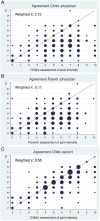A comparison of pain assessment by physicians, parents and children in an outpatient setting
- PMID: 27797872
- PMCID: PMC5502236
- DOI: 10.1136/emermed-2016-205825
A comparison of pain assessment by physicians, parents and children in an outpatient setting
Abstract
Introduction: Our objective was to compare pain assessments by patients, parents and physicians in children with different medical conditions, and analyse how this affected the physicians' administration of pain relief.
Patients and methods: This cross-sectional study involved 243 children aged 3-15 years treated at Bergen Accident and Emergency Department (ED) in 2011. The child patient's pain intensity was measured using age-adapted scales while parents and physicians did independent numeric rating scale (NRS) assessments.
Results: Physicians assessed the child's mean pain to be NRS=3.2 (SD 2.0), parents: NRS=4.8 (SD 2.2) and children: NRS=5.5 (SD 2.4). The overall child-parent agreement was moderate (Cohen's weighted κ=0.55), but low between child-physician (κ=0.12) and parent-physician (κ=0.17). Physicians significantly underestimated pain in all paediatric patients ≥3 years old and in all categories of medical conditions. However, the difference in pain assessment between child and physician was significantly lower for fractures (NRS=1.2; 95% CI 0.5 to 2.0) compared to wounds (NRS=3.4; CI 2.2 to 4.5; p=0.001), infections (NRS=3.1; CI 2.2 to 4.0; p=0.002) and soft tissue injuries (NRS=2.4; CI 1.9 to 2.9; p=0.007). The physicians' pain assessment improved with increasing levels of pain, but only 42.1% of children with severe pain (NRS≥7) received pain relief.
Conclusions: Paediatric pain was significantly underestimated by ED physicians. In the absence of a self-report from the child, parents' evaluation should be listened to. Despite improved pain assessments in children with fractures and when pain was perceived to be severe, it is worrying that barely half of the children with severe pain received analgesics in the ED.
Keywords: clinical assessment; emergency department management; fractures and dislocations; paediatrics, paediatric injury; pain management.
Published by the BMJ Publishing Group Limited. For permission to use (where not already granted under a licence) please go to http://www.bmj.com/company/products-services/rights-and-licensing/.
Conflict of interest statement
Figures


Similar articles
-
Physicians' use of pain scale and treatment procedures among children and youth in emergency primary care - a cross sectional study.BMC Emerg Med. 2015 Nov 6;15:33. doi: 10.1186/s12873-015-0059-9. BMC Emerg Med. 2015. PMID: 26546172 Free PMC article.
-
Paediatric pain assessment: differences between triage nurse, child and parent.J Paediatr Child Health. 2009 Apr;45(4):199-203. doi: 10.1111/j.1440-1754.2008.01454.x. J Paediatr Child Health. 2009. PMID: 19426378
-
Parental perception of the adequacy of pain control in their child after discharge from the emergency department.Pediatr Emerg Care. 1998 Aug;14(4):251-3. doi: 10.1097/00006565-199808000-00001. Pediatr Emerg Care. 1998. PMID: 9733244
-
The Challenges of Providing Effective Pain Management for Children in the Pediatric Intensive Care Unit.Pain Manag Nurs. 2016 Dec;17(6):372-383. doi: 10.1016/j.pmn.2016.08.005. Epub 2016 Oct 15. Pain Manag Nurs. 2016. PMID: 27756590 Review.
-
Pediatric pain management - what are we able to do in Polish emergency medical services?Wiad Lek. 2016;69(3 pt 2):548-554. Wiad Lek. 2016. PMID: 28478424 Review.
Cited by
-
Prevalence of pain reports in pediatric primary care and association with demographics, body mass index, and exam findings: a cross-sectional study.BMC Pediatr. 2018 Nov 21;18(1):363. doi: 10.1186/s12887-018-1335-0. BMC Pediatr. 2018. PMID: 30463543 Free PMC article.
-
Cross-sectional study of pediatric pain prevalence, assessment, and treatment at a Canadian tertiary hospital.Can J Pain. 2021 Sep 29;5(1):172-182. doi: 10.1080/24740527.2021.1961081. eCollection 2021. Can J Pain. 2021. PMID: 34616998 Free PMC article.
-
How Returning Aggregate Research Results Impacts Interest in Research Engagement and Planned Actions Relevant to Health Care Decision Making: Cohort Study.J Med Internet Res. 2018 Dec 21;20(12):e10647. doi: 10.2196/10647. J Med Internet Res. 2018. PMID: 30578228 Free PMC article.
-
Parental Assessment of Postsurgical Pain in Infants at Home Using Artificial Intelligence-Enabled and Observer-Based Tools: Construct Validity and Clinical Utility Evaluation Study.JMIR Pediatr Parent. 2024 Dec 3;7:e64669. doi: 10.2196/64669. JMIR Pediatr Parent. 2024. PMID: 39626240 Free PMC article.
-
Consistency of pediatric pain ratings between dyads: an updated meta-analysis and metaregression.Pain Rep. 2022 Sep 22;7(5):e1029. doi: 10.1097/PR9.0000000000001029. eCollection 2022 Sep-Oct. Pain Rep. 2022. PMID: 36168394 Free PMC article.
References
-
- Brennan F, Carr DB, Cousins M. Pain management: a fundamental human right. Anesth Analg 2007;105:205–21. - PubMed
-
- Fein JA, Zempsky WT, Cravero JP, Committee on Pediatric Emergency Medicine and Section on Anesthesiology and Pain Medicine; American Academy of Pediatrics. Relief of pain and anxiety in pediatric patients in emergency medical systems. Pediatrics 2012;130:e1391–405. 10.1542/peds.2012-2536 - DOI - PubMed
MeSH terms
Substances
LinkOut - more resources
Full Text Sources
Other Literature Sources
